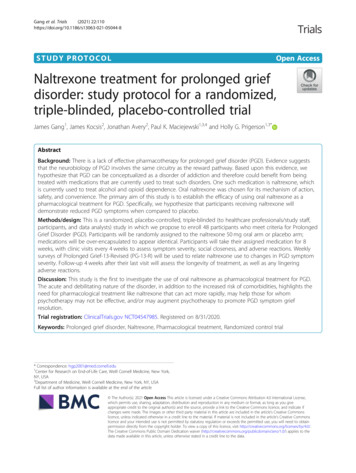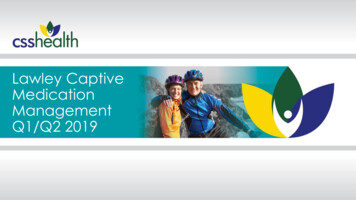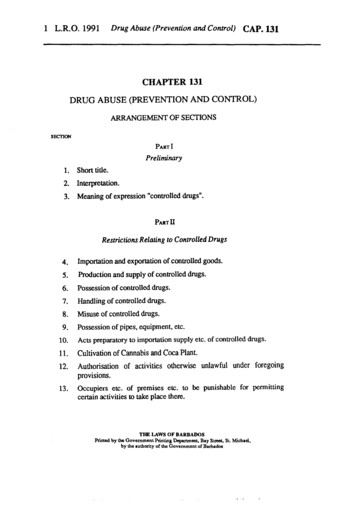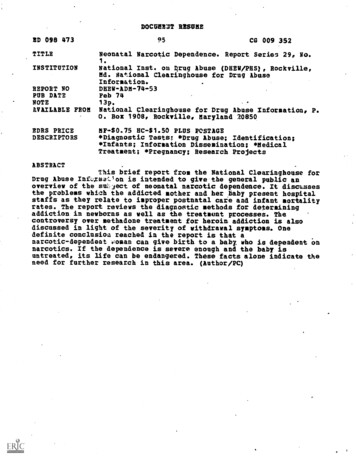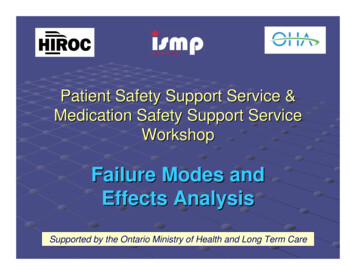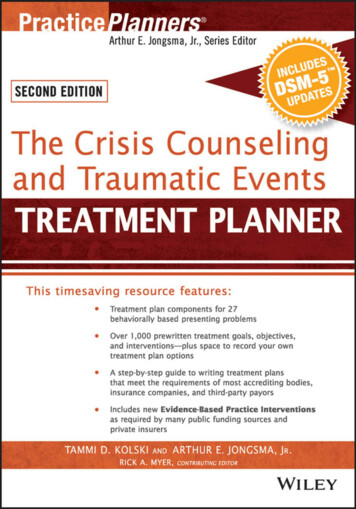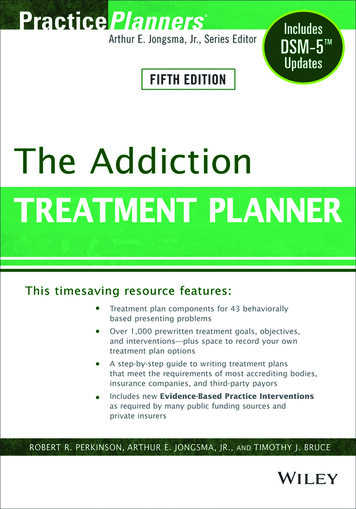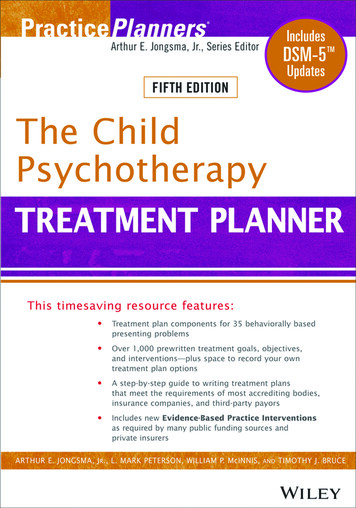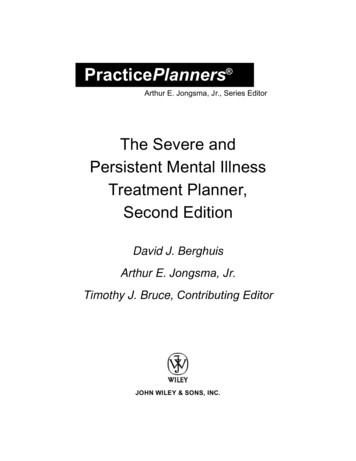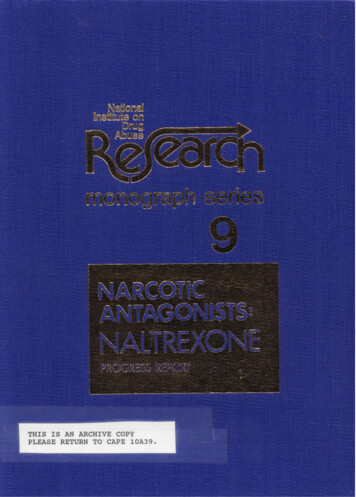
Transcription
NARCOTICANTAGONISTS:NALTREXONEPROGRESS REPORTEditorsDemetrios Julius M.D.Pierre Renault, M.D.Division of ResearchNational Institute on Drug AbuseSeptember 1976NIDA Research Monograph 9U. S. DEPARTMENT OF HEALTH, EDUCATION, AND WELFAREPublic Health ServiceAlcohol, Drug Abuse and Mental Health Administration
The NIDA Research Monograph series is prepared by theDivision of Research of the National Institute on Drug Abuse. Itsprimary objective is to provide critical reviews of research problemareas and techniques, the content of state-of-the-art conferences,integrative research reviews and significant oriainal research. Itsdual publication emphasis is rapid and targeted dissemination to thescientific and professional community.EDITORIAL ADVISORY BOARDAvram Goldstein, M.D.Jerome Jaffe, M.D.Reese T. Jones, M.D.William McGlothlin, Ph.D.Jack Mendelson, M.D.Helen Nowlis, Ph.D.Lee Robins, Ph.D.Addiction Research FoundationPalo Alto, CaliforniaCollege of Physicians and SurgeonsColumbia University, New YorkLangley Porter Neuropsychiatric InstituteUnversity of CaliforniaSan Francisco, CaliforniaDepartment of Psychology, UCLALos Angeles, CaliforniaAlcohol and Drug Abuse Research CenterHarvard Medical SchoolMcLean HospitalBelmont, MassachusettsOffice of Drug Education, DHEWW ashington, D.C.Washington University School of MedicineSt. Louis, MissouriNIDA RESEARCH MONOGRAPH seriesRobert DuPont, M.D. DIRECTOR, NIDAWilliam Pollin, M.D.DIRECTOR, DIVISION OF RESEARCH, NIDARobert C. Petersen, Ph.D. EDITOR-IN-CHIEFEunice L. Corfman, M.A. EDITORRockwall Building 11400 Rockville Pike Rockville, Maryland, 20852
NARCOTICANTAGONISTS:NALTREXONEPROGRESS REPORT
ACKNOWLEDGMENTSThe editors wish to thank the National Academy of Sciences’Committee on Problems of Drug Dependence for graciously encouraging the inclusion of a Satellite Conference on Naltrexone into its 38th Annual Scientific Meeting held inRichmond, Virginia on June 7th to 9th, 1976. They wouldlike to thank Mr. Alex Bradford and his staff at BiometricResearch Institute for masterfully organizing the successful naltrexone conference. It was from this conference,and the enthusiastic response and well conceived papers ofthe participants, that this research monograph was derived.DHEW publication number (ADM) 76-387Library of Congress catalog card number 76-40692This document is for sale by National Technical Information ServiceSpringfield, Va. 22161Order number: PB 255 833. Papercopy: 7.50; Microfiche: 2.25iv
FOREWORDThe Conference on naltrexone reported here represents another step in acarefully designed plan to develop better treatment methods for opioiddependence. The early theoretical foundations for the use of antagonistswere laid down by Abraham Wikler in 1955, when he postulated that physicaldependence on opioids provided a continually recurring “synthetic” needthat was readily satisfied by the use of opioids, that withdrawal phenomena could be conditioned to environmental stimuli, and that such conditioning played an important role in relapse to drug use long after drugwithdrawal was completed.A decade elapsed before these views on the role ofopioids in the reinforcement of drug seeking behavior and of conditioning could be applied totreatment in a practical way. In a series of papers, beginning in 1965,William Martin and his co-workers at the Addiction Research Center atLexington, Kentucky, presented the clinical pharmacology of cyclazocine,a long-acting, orally effective narcotic antagonist, and suggested the waysin which drugs like cyclazocine might be used in treatment. In essence,Martin and his colleagues pointed out that cyclazocine would block theeffects of acutely administered opioids, that when cyclazocine was givendaily even chronicopioiduse would not produce physical dependence, thattolerance did not develop to the antagonistic effects of cyclazocine,and that cyclazocine itself (while not as aversive as nalorphine), was nota drug likely to be abused. Thus, chronically administered cyclazocinehad the potential of 1) blocking the positive reinforcement of drug seeking behavior permitting extinction to occur; 2) preventing the developmentof physical dependence, thereby eliminating relief of withdrawal as asource of reinforcement; and 3) preventing readdiction, permitting thephenomena associated with protracted withdrawal to undergo a gradual resolution. Lastly, the use of antagonists might prevent death from narcoticoverdosage even if it did not eliminate drug seeking behavior.The question of whether opioid addicts would voluntarily accept treatmentwith a drug like cyclazocine, which promised nothing other than to preventthem from feeling the effects ofopioiddrugs, was quickly answered. Jaffeand Brill in 1966 and Freedman et al. in 1967, reported their experienceswith heroin addicts who volunteered to participate in treatment programscentered around the use of cyclazocine. It was apparent that there didexist a group ofopioid dependent individuals who, at some point, weremotivated to become totally independent of the need for opioid drugs.v
However, several problems became apparent in these early clinical studiesproblems which are not yet entirely resolved, but which led directly tothis conference and to our present state of knowledge. First, most ofthe subjects who volunteered for treatment with cyclazocine frequentlyneglected to take the drug on a regular basis; most dropped out of treatment within a few months, and by the time they were contacted many hadrelapsed to regular opioid use (usually heroin). Second, many addictsdiscontinued treatment complaining of the unpleasant side effects thatcyclazocine produced. While such complaints often seemed to the investigators to be rationalizations, from a practical point of view it was difficult to persuade patients to continue with treatment. In order to test theconditioning theory and to determine if antagonists could play a usefulrole in treatment, better antagonists were needed, i.e., drugs that werefreer of side effects and drugs that would have such a long duration ofaction that daily ingestion would be unnecessary. It was apparent that thiswas primarily a technological problem, and one that given time and moneycould be solved.Thus, by 1967 the basic strategy that would be required to test the utilityof narcotic antagonists in the treatment of opiate dependence was largelyshaped. Although Freedman and Fink and their co-workers continued toexplore the possibilities of using high doses of oral naloxone, a relativelypure antagonist, most investigators felt that its short duration of actionand relative ineffectiveness by mouth limited its usefulness. In thatsame year, 1967, Blumberg and his colleagues reported on the effects inanimals of a new oxymorphone-derived antagonist, EN-1639A, later to becalled naltrexone. Naltrexone seemed to be the sought after antagonist-relatively free of agonistic activity, and with a longer duration of actionthan noloxone. Although the formal archival publications did not appearuntil 1973, at the 1971 meeting of the NAS/NRC Committee on Problems ofDrug Dependence Martin, Jasinski and their co-workers reported that inpost-addicts naltrexone was orally effective, long-acting and relativelyfree of side effects.The effort to move naltrexone from these preliminary observations on afew patients at the Addiction Research Center at Lexington to the hands ofclinical investigators where its efficacy might eventually be tested wasgiven sudden acceleration when President Nixon created the Special ActionOffice for Drug Abuse Prevention (SAODAP) on June 17, 1971. Along withthis office, established within the Executive Office of the President,came both the economic resources and the influence needed to speed up thedevelopment of narcotic antagonists. As the first director of SAODAP, Iregarded the development of naltrexone as one of my high priorities.However, even if I had not felt that the development of naltrexone wasworthwhile, I would have felt obliged nevertheless to bend every efforttoward its clinical development. Influential members of Congress hadbecome enthusiastic about the possibility of a non-dependence producingpharmacological alternative to the use of methadone. The Congress includedin the legislation creating SAODAP a section on the development of antagonists along with appropriations to be used specifically for such development.vi
There have been numerous stumbling blocks along the way. Some of themrelated to supplies of thebaine, the precursor used in the manufactureof naltrexone, and the limited production of the drug. In addition, notwanting to place all bets on a single drug, SAODAP initiated researchwith other antagonists; and recognizing that eventually even the two tothree day duration of action of naltrexone would prove to be too short,SAODAP also initiated the effort to develop long-acting depot preparations.Ultimately, money, people and experimental designs were combined in amanner required to produce the products and the data.At various times over the past decade, as the effort to test the utilityof antagonists progressed, I pointed out that despite their great theoretical promise, antagonists might prove to be of value for only a limitedsubgroup within the opioid using population. Yet, each of those timesthere seemed to be little alternative to getting on with the effort tosubject antagonists to careful clinical testing and the resultant data torigorous and objective analysis. Some of the results of this long termeffort are presented here.Jerome Jaffe, M.D.College of Physicians and SurgeonsColumbia University, New Yorkvii
CONTENTSForewordJerome JaffevINTRODUCTIONPierre Renault, M.D.1THE FEDERAL ROLE IN NALTREXONE DEVELOPMENTNIDA'S NALTREXONE RESEARCH PROGRAMDemetrios Julius, M.D.5REQUIREMENTS FOR DRUG DEVELOPMENTEdward C. Tocus, Ph.D.12PRECLINICAL TOXICITY STUDIES OF NALTREXONEMonique C. Braude, Ph.D. and J. Michael Morrison, M.S.16THE EFFECTS OF NALTREXONE IN THE CHRONIC SPINAL DOG AND ACUTE SPINAL CAT; POSSIBLEINTERACTION WITH NATURALLY - OCCURRING MORPHINE-LIKE ANTAGONISTS27William Martin, M.D., James Bell, Ph.D., Paul Gilbert, Ph.D., Jewell Sloan, B.S.,James ThompsonTHE DEVELOPMENT OF SUSTAINED ACTION PREPARATIONS OF NARCOTIC ANTAGONISTSRobert E. Willette, Ph.D.31THE NAS DOUBLE-BLIND STUDYEVOLUTION OF THE NATIONAL ACADEMY OF SCIENCES STUDY OF NALTREXONESamuel C. Kaim, M.D.37PHILOSOPHY AND STATUS OF THE NAS CENA STUDIESLeo E. Hollister, M.D.45VARYING CLINICAL CONTEXTS FOR ADMINISTERING NALTREXONEMarc Hurzeler, M.D., David Gewirtz, M.S., Herbert Kleber, M.D.48PATIENT RESPONSE TO NALTREXONE: ISSUES OF ACCEPTANCE, TREATMENT EFFECTS AND FREQUENCYOF ADMINISTRATIONStephen Curran, M.A., and Charles Savage, M.D.67NALTREXONE IN METHANE MAINTENANCE PATIENTS ELECTING TO BECOME "DRUG FREE"Neil Haas, M.D., Walter Ling, M.D., Elaine Holmes, Ph.D., Mara Blakis, M.D.,Margaret Litaker, MSW70COMMENTS AND FINDINGS FROM A NALTREXONE DOUBLE-BLIND STUDYJohn Keegan, M.A., Carol Lavenduski, A.C.S.W., Kenneth Schoof, M.D.74FACTORS INFLUENCING SUCCESS IN AN ANTAGONIST TREATMENT PROGRAMSadashiv Parwatikar, M.D., FRCP (C), James Crawford, M.S., John V. Nelkupa,Chona DeGracia, M.D.77ix
THE NIDA CLINICAL STUDIESA POINT OF VIEW CONCERNING TREATMENT APPROACHES WITH NARCOTIC ANTAGONISTSRichard B. Resnick, M.D., and Elaine Schuyten-Resnick, M.S.W.84CLINICAL EXPERIENCE WITH NALTREXONE IN 370 DETOXIFIED ADDICTSMuriel Thomas R.N., Frank Kauders, M.D., Marcel Harris, Judy Cooperstein, R.N.,Gordon Hough, Ph.D., Richard Resnick, M.D.88NARCOTIC ANTAGONIST TREATMENT OF THE CRIMINAL JUSTICE PATIENT - INSTITUTIONAL VSOUTPATIENT - INCLUDING A 24-HOUR DETOX NALTREXONE INDUCTION REGIMEN WITH ORAL MEDICATIONLeonard Brahen, Ph.D., M.D., Victoria Wiechert, MPS, Thomas Capone, Ph.D.USE OF NARCOTIC ANTAGONISTS (NALTREXONE) IN AN ADDICTION TREATMENT PROGRAMDavid Lewis, M.D., Ronald Hersch, Ph.D., Rebecca Black, Ph.D.,Joseph Mayer, Ph.D.AN ANALYSIS OF NALTREXONE USE - ITS EFFICACY, SAFETY AND POTENTIALRalph Landsberg, D.O., Zebulon Taintor, M.D., Marjorie Plumb, Ph.D.Leonard Amico, B.A., Nancy Wicks, B.S.CLINICAL EFFICACY OF NALTREXONE: A ONE YEAR FOLLOW-UPRichard Resnick, M.D., Michael Aronoff, M.D., Greta Lonborg, M.A.,Richard Kestenbaum, Ph.D., Frank Kauders, M.D., Arnold Washton, Ph.D.Gordon Hough, Ph.D.9399106114THE NIDA BEHAVIORAL STUDIESTHE THEORETICAL BASIS OF NARCOTIC ADDICTION TREATMENT WITH NARCOTIC ANTAGONISTS 120Abraham Wikler, M.D.LIMITATIONS OF AN EXTINCTION APPROACH TO NARCOTIC ANTAGONIST TREATMENTRoger E. Meyer, M.D., Mary Randall, M.S., Cecily Barrington, B.A.,Steven M. Mirin, M.D., Isaac Greenberg, Ph.D.123NALTREXONE IN A BEHAVIORAL TREATMENT PROGRAMCharles P. O'Brien, M.D., Ph.D., and Robert Greenstein, M.D.136CLINICAL EXPERIENCE WITH NALTREXONE IN A BEHAVIORAL RESEARCH STUDYRobert Greenstein, M.D., Charles O'Brien, M.D., Ph.D., Jim Mintz, Ph.D.,George E. Woody, M.D., Nancy Hanna, B.A.141COMPARISON OF TWO NALTREXONE TREATMENT PROGRAMS: NALTREXONE ALONE VERSUS NALTREXONEPLUS BEHAVIOR THERAPYEdward Callahan, Ph.D., Richard Rawson, Ph.D., Michael Glazer, M.A.,Beverly McCleave, B.A., Richard Arias, B.A.NALTREXONE IN THE MANAGEMENT OF HEROIN ADDICTION: CRITIQUE OF THE RATIONALEAvram Goldstein, M.D.150158CURRENT STATUS OF NALTREXONE SAFETY DATAINTERIM REPORT ON CLINIC INTAKE AND SAFETY DATA COLLECTED FROM 17 NIDA-FUNDED NALTREXONE163STUDIESH. Alex Bradford; M.S., Frank L. Hurley, Ph.D., Oksana Golondzowski,Catharine DorrierAGENDA - NAS - NIDA SATELLITE CONFERENCE ON NALTREXONE172NALTREXONE BIBLIOGRAPHY176IS180x
INTRODUCTIONPierre F . Renault, M.D.With the end of Phase II clinical testing ofnaltrexone in sight and the planning forPhase III underway, this seems an appropriatetime to take stock, review our accomplishmerits, and re-evaluate our theories and preconceptions. Obviously, this cannot be donecompletely in only one volume. The fullpromise of naltrexone will only be realizedafter years of clinical innovation and careful observation. The purpose of this volumeis to inform, act as a reference for clinicalprocedures, encourage interest and possiblystimulate further innovation and researchwith this important new drug.process of drug development. Dr. Hollistergives a candid portrayal of many underlyingpressures that, fueledbysimplistic thinkingand unrealistic expectation, complicated thebeginning of naltrexone’s development. Dr.Hollister’s paper highlights a tension whichis evident in other papers in this volume, atension between the wish to respond to society’sdemand that a solution be found for the problem of heroin abuse and the wish to developeffective treatment for afflicted individualswithout exposing volunteer subjects to unduerisk. While it is true that political pressurewas important in overcoming the inertia andgetting naltrexone development underway, thepace of development has been in step with thepace of development of safety data and therequirements of the FDA. The paper by Dr.Willette on long-acting preparationspoints us toward the future. Many questionsremain unanswered. What place will a sustainedrelease preparation have in future treatment?Will it provide protection against the impulsewith gradual extinction, or will it simply beanother “sentence” removing responsibility fromthe patient and only delaying the eventual confrontation with heroin availability? How canthese preparations be overridden when analgesiais necessary?The volume contains a series of five papersrecounting the history of the political andbureaucratic processes necessary to havegotten us this far in the development of naltrexone. Dr. Julius gives a comprehensivestatement of the interest of the Federal government in making a narcotic antagonist available for use in the treatment of chronic opioiddependence. Dr. Kaim details the decisionswhich led to the formation of the CENA committee and the National Academy of Sciencesstudy. Dr. Tocus outlines the procedures thatthe Food and Drug Administration has developedto assure us of the safety and efficacy of allthe drugs marketed in this country. This is aparticularly helpful paper because it catalogs a process that most clinicians andscientists find bewildering. Braude and Morrison summarize the preclinical animal toxicitystudies, a crucial and difficult step in theAlthough much of our primary concern has beenthe development of naltrexone as a clinicallyuseful medication, the paper by Martin, et al,on the possible interaction of naltrexone with“naturally occurring morphine-like agonists”1
indicates the importance of research on naltrexone in the development of knowledge aboutthe basic processes of opioid action and physical dependence. “‘Pure” antagonists have noknown effect on normal organisms, but theymay have important effects in organisms whoseendogenous morphine-like substance (endorphin)system has been disequilibriated by chronicadministration of opioid drugs. This possibility relates directly to Dr. Wikler’s paperand his interest in a possible “satiating”effect of naltrexone in addicts. Later in thevolume Thomas, et al, and Landsberg? et al,give clinical examples of such “satiation,”and Goldstein supports the likelihood of thisinteraction.tion of patients in their behavior therapytechniques aimed at lifestyle change.In his paper Dr. Wikler continues his tradition of provocative theorizing about theaddiction process and innovation in treatmentmethods. He reviews the concept of extinctionwhich formed the basis for the use of narcoticantagonists in treatment. Convinced that extinction is the process which must occur forcomplete recovery from compulsive opioid use,Dr. Wikler suggests new ways of overcomingthe failure of extinction to generalize beyondthe therapeutic setting. Meyer, et al, havedone extensive testing of the extinction theoryunder controlled conditions. They found thatextinction achieved in a controlled inpatientsetting did not generalize. Those patientswho did well were those who continued to taketheir naltrexone after discharge and who mademajor lifestyle changes. This group of investigations has extended our understanding ofhuman heroin taking by making systematicobservations of heroin self-administration byindividuals who did not know whether they wereblocked by naltrexone or not blocked by placebo.It took longest for extinction to occur inthose individuals with the longest history ofheroin use. They have also demonstrated thatinterpersonal factors outweigh pharmacologicalfactors in determining continued heroin use.They also advance the concept that takingnaltrexone creates the “stimulus state” thatsignals heroin is “unavailable” and thattherefore, addicts treated with naltrexonemust eventually face the day when treatmentceases and heroin again becomes available.This concept resonates with the clinical concepts, later in the volume, of Lewis and Resnick, who feel that dropping out and returningto treatment are part of a process of gainingcontrol over this state of facing heroinavailability.Three investigators, Lewis, Resnick, et al,and Goldstein present clinical ideas on improving the efficacy of naltrexone. Lewisfeels that a “permissive” attitude on thepart of clinic staff is helpful in allowingpatients to make full use of naltrexone. Thegoal of treatment is “internalization of control.” Missing doses and clinic appointmentscan be seen as effortstointemalize the protection against the impulse to take heroinwhich naltrexone provides. Resnick, et al, intheir followup study give data to support this“permissive” attitude by pointing out thatsubsequent treatment periods, after relapses,tend to increase in duration, that duration ofnaltrexone treatment is correlated with eventual success, and that a decision to takenaltrexone is a “responsible” decision not totake heroin. They feel that the clinic staffmust develop the trust of the client, so thathe will transfer his reliance from drugs tohis counselor.Each of the investigators involved in theclinical trials of naltrexone was asked tosummarize his experiences and to describeactual clinical procedures to provide a reference source of clinical experience for otherinvestigators who plan to do clinical researchwith this drug. A wide variety of experienceis represented in these papers. Among theparticipants in the NAS Cooperative Study,Parwatikar, et al, treated street addicts.Hurzeler, et al, and Curran, et al, treatedprimarily patients from the criminal justicesystem who were not currently physicallydependent. Haas, et al, and Schoof, et al,inducted patients from methadone maintenancewho required detoxification. Among the NIDAClinical Study participants, Thomas, et al,have had the most extensive experience withnaltrexone in a general clinic population.Greenstein, et al, have also treated a substantial number of patients and they give avery detailed description of the clinic procedures. Brahen, et al, also give details ofa unique and important application of antagonist treatment within the criminal justicesystem.All the clinical papers fulfilled our requestfor detailed information on clinic procedures.Their impressions and results are consonant onseveral issues:1.O’Brien, et al, review their procedures foroutpatient extinction trials. Callahan, etal, while agreeing that change in lifestylemust be the ultimate goal of naltrexone treatment, find that naltrexone aids the coopera-2.2Naltrexone is safe in the population tested,otherwise healthy male heroin addictsrequesting treatment.The major side effect is in the gastrointestinal system. The major symptoms are
3.4.5.6.7.8.9.10.anorexia, nausea and vomiting, and abdominal cramping.They are unanimous in their agreement thatnaltrexone, at the equivalent of 50 mg/day,completely blocks euphoria and the development of physical dependence from streetheroin.The induction procedures currently employedare satisfactory.The greatest problem with retentionoccurred during the detoxification process.Patients either could not complete detoxification or upon completion decided theydid not need further medication.The study itself, especially the doubleblind study, was a factor in causing a lowretention rate.Retention in treatment is not an adequatemeasure of outcome.Naltrexone is a drug for the highlymotivated.The goal of treatment should be focused onchange of lifestyle.The patient maintained on naltrexone musteventually face a crisis when he attemptsto maintain control in the absence of naltrexone and heroin is again available.were experienced as side effects; but wouldan antagonist with some reinforcing agonisticproperties be more acceptable to patients andtherefore effective in a larger propertion ofpatients? Does a pure antagonist such as naltrexone have a healing action on the disequilibriated “endorphin” system? What arethe effects of naltrexone on protracted abstinence? Is naltrexone best viewed as amaintenance or a crisis drug?It is our intent that this volume mark a pointin time when we begin the final developmentalphase. Our accomplishments consist of a bodyof thought and data on opioid dependence andstrategies of intervention with naltrexone.Naltrexone is thus far safe and efficacious.Its usefulness is limited to a minority ofpatients characterized by their motivation.Perhaps naltrexone is not Dr. Hollister’s“new magic bullet” for heroin addiction, butit has stimulated the imagination of researchers in this field and its promise seems tochange and grow as our knowledge and understanding of basic processes increases.The papers have been grouped roughly in thesame fashion as they were presented at theNational Academy of Science’s Satellite Naltrexone Conference, held June 6 and 7, 1976,in Richmond, Virginia. The first set ofpapers describes the Federal role in thedevelopment of naltrexone. The second groupof papers describes the conceptual basis andthe results of the double-blind study of naltrexone’s clinical safety and efficacy conducted by the National Academy of Science’sCommittee on the Evaluation of Narcotic Antagonists (CENA) . The third group of papers dealswith the NIDA open clinical studies of naltrexone safety and efficacy. The fourth groupof papers includes theoretical discussion andthe clinical testing of behavioral hypothesesconcerning the treatment of opiate addictionwith narcotic antagonists. The last paper isa current assessment of the data collected onnaltrexone safety to date.Bradford has compiled an interim report on thecombined safety data collected in 17 separateclinics involving 883 subjects who took studymedication. Review of this data confirmsclinical impressions presented earlier. Thereis no evidence of naltrexone being toxic.Specific symptoms: loss of appetite, nauseaand vomiting, abdominal cramps and constipation did occur at a slightly higher frequencyamong naltrexone patients.Broader questions also remain. Who are thepatients likely to benefit from narcoticantagonist treatment? Are there any lowincidence side effects of naltrexone? Isnaltrexone the “ideal” antagonist? Naltrexonewas chosen because of its lack of agonisticproperties, which in the case of cyclazocineAUTHORPierre Renault, M.D.National Institute on Drug AbuseDivision of Research3
THE FEDERAL ROLE IN NALTREXONE DEVELOPMENT
NIDA’S NALTREXONERESEARCH PROGRAMDemetrios Julius, M.D.The current naltrexone research program supported by the National Institute on DrugAbuse can be traced developmentally to itsembryonic beginnings in the mid-1960’s. Atthat time Dr. William Martin and his coworkers at the Addiction Research Center inLexington, Kentucky initiated a series ofstudies into the use of narcotic antagonistsfor the treatment of opioid dependence (Martin et al. , 1966). The studies were a practical outgrowth of the theoretical formulations elaborated by Dr. Abraham Wikler overthe preceding years (Wikler, 1948 and 1965).The results of the studies showed that anarcotic antagonist could be effectively usedto block the euphorigenic and dependenceproducing properties of opioids in man. Furthermore, this chemotherapeutic agent wouldproduce neither physical dependence nor abuseliability in the treated individual. Thiswas important because previous treatment drugshad the liability of producing their owndegree of addiction.avenues of relief. Many chose to seek refugein what was felt to be the blissful escapeprovided by illicit drugs. This could beviewed sociologically as a massive attempt atFor many individuals, oneself-medication.dead-end to which these pharmacologicalavenues led was heroin addiction. Consequently by 1970 the use of heroin both athome and among our military personnel abroadhad reached epidemic proportions. Amongnational authorities, apocalyptic visions ofopioid-dependent armed United States soldiers,as well as similarly afflicted anti-war, antiAmerican anarchists roaming the streets looking for a “fix,” provided necessary impetusto both the Executive and Legislative Branchesof the Government to authorize funding forexpanded research and treatment of opioiddependence.On June 17, 1971, President Nixon signed intocreation the Special Action Office for DrugAbuse Prevention (SAODAP), to coordinate thevarious resources of the cederal Governmentnecessary to check the continuing spread ofillicit drug abuse. These resources for drugabuse research, prevention, and treatment hadbeen previously scattered across more thanfourteen different agencies. In 1972, theCongress passed the Drug Abuse Office andTreatment Act which was signed into Public Law92-255, Section 224, 86 statement 72 on March21, 1972. Among the numerous provisions ofthe Law was a substantial financial supportfor the expansion of research on “long-lasting,non-addictive. blocking and antagonist drugs orThese early clinical studies into the therapeutic use of narcotic antagonists might havefaded into textbook obscurity had it not beenfor a number of concurrent social and political events that were rapidly developing. Inthe years following the tragedy of PresidentKennedy’s assassination on November 22, 1963,our nation was quickly pulled into socialturmoil at home and military turmoil abroad.By the late 1960’s this multi-determinedchaotic national scene had led hundreds ofthousands of individuals to seek multiple5
dependent individuals have described the onset of withdrawal symptoms by merely cominginto contact with their previous environment.This conditioned abstinence syndrome may becharacterized by increased reactivity tostimuli, prolonged abnormal autonomic responses, feelings of dysphoria, and often anintense “craving.”other pharmacological substances for thetreatment of heroin addiction.” With thesesubstantial mandates, SAODAP’s first director,Dr. Jerome Jaffe, set the development of asafe and effective narcotic antagonist as oneof the highest priorities for this new agency.THEORETICAL BASIS OF NARCOTICANTAGONIST THERAPYQuite logically, it was theorized, the narcotic antagonist could be used to controlthese various determinants of drug-seekingbehavior. Since the antagonist would blockthe euphoria and the dependence produced bythe opiates, the reinforcement for drugseeking behavior provided by these two critical determinants of opioid dependence wouldgradually be attenuated. Furthermore, theantagonist would protect the detoxified individual against the conditioned abstinencesyndrome. Thus, with the absence of thesereinforcers would come the gradual extinctionof the drug-seeking behavior itself.Pharmacologically, a narcotic antagonist is asubstance which has the ability to block theeuphorigenic and dependence-producing properties of opioids (Martin, 1967). At thepresent time, it is theorized that this typeof drug accomplishes this feat because of itsstructural similarity to narcotics themselves.Thus, antagonists have the ability to occupythe same presumed opiate receptor sites inthe body as the narcotics do, and therebyproduce competitive inhibition of narcotics.Differen
College of Physicians and Surgeons Columbia University, New York Langley Porter Neuropsychiatric Institute Unversity of California San Francisco, California Department of Psychology, UCLA Los Angeles, California Alcohol and Drug Abuse Research Center Harvard Medical School McLean Hospital Belmont, Massachusetts Office of Drug Education, DHEW .
